Coordinated Operation Strategy for Large Wind Power Base Considering Wind Power Uncertainty and Frequency Stability Constraint
Abstract
1. Introduction
- The analytical expressions of frequency stability constraints are derived, which makes up for the disadvantage that existing frequency stability constraints are difficult to accurately describe the transient characteristics.
- A novel scheduling mechanism is established in which the uncertainty is resisted by the uncertainty source itself, and the corresponding COS model is proposed.
- The new scheduling mechanism increases the nonlinearity and the solving difficulty of the COS problem; a linearization technique is proposed to cope with this problem.
2. Frequency Response Characteristics of WTs and BESSs
2.1. Frequency Response Characteristics of WTs
2.2. Frequency Response Characteristics of BESSs
3. Frequency Stability Constraints
- When power fluctuations or one fault with high probability occur in the system, the maximum RoCoF vR does not exceed a specified threshold value vRc;
- When power fluctuations or one fault with high probability occur in the system, the overshoot δ% does not exceed a specified threshold value δc%;
- When power fluctuations or one fault with high probability occur in the system, the steady-state frequency deviation Δfst does not exceed a specified threshold value Δfsc.
4. Robust Optimization Model Considering Wind Power Uncertainty
4.1. Wind Power Uncertainty
4.2. COS Model Considering Frequency Stability Constraints
- Power balance constraints
- Output constraints of the synchronous generators are as follows:
- Ramp speed constraints of the synchronous generators are as follows:
- Minimum on/off time limits of the synchronous generators are as follows:
- Start-up and shut-down operations constraints of the synchronous generators are as follows:
- Output constraints of the WTs are as follows:
- Power and energy constraints of the BESSs are as follows:
- RoCoF constraints
- The overshoot constraint of the frequency response
- Steady-state frequency deviation constraint
- Line overload constraint
4.3. Wind Power Uncertainty Handling
4.4. Solution of the Optimization Model
| Algorithm 1. Benders decomposition for the equivalent MILP problem. |
Procedure of Algorithm 1.
|
5. Case Study
5.1. Modified IEEE 39-Bus System
5.1.1. Test System Description
5.1.2. Robustness Verification of Optimization Model to Wind Power Uncertainty
5.1.3. Influence of Frequency Stability Constraints
5.1.4. Smoothing Effect of the BESS on the Wind Power Fluctuations
5.1.5. Effect of the WTs on Frequency Stability
5.2. Modified Illinois 200-Bus System
6. Conclusions
Supplementary Materials
Author Contributions
Funding
Data Availability Statement
Conflicts of Interest
Abbreviations
| WT | Wind Turbine |
| BESS | Battery Energy Storage System |
| COS | Coordinated Operation Strategy |
| PFR | Primary Frequency Regulation |
| MILP | Mixed Integer Linear Programming |
| UC | Unit Commitment |
| RoCoF | Rate of Change in Frequency |
| SOC | State of Charge |
| MP | Master Problem |
| SP | Sub-Problem |
| SG | Synchronous Generator |
| DP | Dual Problem |
| DFIG | Doubly Fed Induction Generator |
References
- Wang, G.; Wang, C.; Hao, Q.; Shahidehpour, M. Load Frequency Control Method for Cyber-Physical Power Systems With 100% Renewable Energy. IEEE Trans. Power Syst. 2024, 39, 4684–4698. [Google Scholar] [CrossRef]
- Li, X.; Hui, D.; Lai, X. Battery energy storage station (BESS)-based smoothing control of photovoltaic (PV) and wind power generation fluctuations. IEEE Trans. Sustain. Energy 2013, 4, 464–473. [Google Scholar] [CrossRef]
- Zhang, Y.; Zhang, R.; Zhang, Z.; Wang, H.; Shao, B. Design and realization of security checking of day-ahead generation schedules in power market. In Proceedings of the International Conference on Power System Technology, Kunming, China, 13–17 October 2002; Volume 4, pp. 2367–2370. [Google Scholar]
- Huang, Y.; Zhang, J.; Wang, G.; Xu, Z. Transient stability analysis and improvement of isolated renewable energy bases with VSC-DC transmission. CSEE J. Power Energy Syst. 2025. [Google Scholar] [CrossRef]
- Xiao, H.; Gan, H.; Yang, P.; Li, L.; Li, D.; Hao, Q.; Huang, Y.; Dai, L.; Liu, Y. Robust Submodule Fault Management in Modular Multilevel Converters With Nearest Level Modulation for Uninterrupted Power Transmission. IEEE Trans. Power Deliv. 2024, 39, 931–946. [Google Scholar] [CrossRef]
- Li, J.; Zhou, S.; Xu, Y.; Zhu, M.; Ye, L. A multi-band uncertainty set robust method for unit commitment with wind power generation. Int. J. Electr. Power Energy Syst. 2021, 131, 107125. [Google Scholar] [CrossRef]
- Dong, J.; Han, S.; Shao, X.; Tang, L.; Chen, R.; Wu, L.; Zheng, C.; Li, Z.; Li, H. Day-ahead wind-thermal unit commitment considering historical virtual wind power data. Energy 2021, 235, 121324. [Google Scholar] [CrossRef]
- Lu, J.; Liu, T.; He, C.; Nan, L.; Hu, X. Robust day-ahead coordinated scheduling of multi-energy systems with integrated heat-electricity demand response and high penetration of renewable energy. Renew. Energy 2021, 178, 466–482. [Google Scholar] [CrossRef]
- Ma, X.; Ning, C.; Li, L.; Qiu, H.; Gu, W.; Dong, Z. Bayesian Nonparametric Two-Stage Distributionally Robust Unit Commitment Optimization: From Global Multimodality to Local Trimming-Wasserstein Ambiguity. IEEE Trans. Power Syst. 2024, 39, 6702–6715. [Google Scholar] [CrossRef]
- Wu, W.; Wang, Z.; Li, X.; Guo, L.; Liu, Y.; Zhai, J.; Wang, C. Physics-Informed Probability Distribution Assessment for Primary Frequency Regulation Capability of Wind Farms Considering Wind Speed Uncertainty. J. Mod. Power Syst. Clean Energy 2025. [Google Scholar] [CrossRef]
- Guo, Y.; Ming, B.; Huang, Q.; Wang, Y.; Zheng, X.; Zhang, W. Risk-averse day-ahead generation scheduling of hydro–wind–photovoltaic complementary systems considering the steady requirement of power delivery. Appl. Energy 2022, 309, 118467. [Google Scholar] [CrossRef]
- Hou, W.; Wei, H. Data-driven robust day-ahead unit commitment model for hydro/thermal/wind/photovoltaic/nuclear power systems. Int. J. Electr. Power Energy Syst. 2021, 125, 106427. [Google Scholar] [CrossRef]
- Lin, Z.; Chen, H.; Wu, Q.; Huang, J.; Li, M.; Ji, T. A data-adaptive robust unit commitment model considering high penetration of wind power generation and its enhanced uncertainty set. Int. J. Electr. Power Energy Syst. 2021, 129, 106797. [Google Scholar] [CrossRef]
- Hou, W.; Hou, L.; Zhao, S.; Liu, W. A hybrid data-driven robust optimization approach for unit commitment considering volatile wind power. Electr. Power Syst. Res. 2022, 205, 107758. [Google Scholar] [CrossRef]
- Guo, Z.; Wei, W.; Chen, L.; Shahidehpour, M.; Mei, S. Economic Value of Energy Storages in Unit Commitment With Renewables and Its Implication on Storage Sizing. IEEE Trans. Sustain. Energy 2021, 12, 2219–2229. [Google Scholar] [CrossRef]
- Wang, S.; Zheng, N.; Bothwell, C.D.; Xu, Q.; Kasina, S.; Hobbs, B.F. Crediting Variable Renewable Energy and Energy Storage in Capacity Markets: Effects of Unit Commitment and Storage Operation. IEEE Trans. Power Syst. 2022, 37, 617–628. [Google Scholar] [CrossRef]
- Chen, Y.; Baldick, R. Battery Storage Formulation and Impact on Day Ahead Security Constrained Unit Commitment. IEEE Trans. Power Syst. 2022, 37, 3995–4005. [Google Scholar] [CrossRef]
- Wu, X.; Li, N.; He, M.; Wang, X.; Ma, S.; Cao, J. Risk-constrained day-ahead scheduling for gravity energy storage system and wind turbine based on IGDT. Renew. Energy 2022, 185, 904–915. [Google Scholar] [CrossRef]
- Hong, Y.-Y.; Apolinario, G.F.D.; Lu, T.-K.; Chu, C.-C. Chance-constrained unit commitment with energy storage systems in electric power systems. Energy Rep. 2022, 8, 1067–1090. [Google Scholar] [CrossRef]
- Wu, T.; Zhang, Y.A.; Wang, S. Deep Learning to Optimize: Security-Constrained Unit Commitment With Uncertain Wind Power Generation and BESSs. IEEE Trans. Sustain. Energy 2022, 13, 231–240. [Google Scholar] [CrossRef]
- Hao, L.; Ji, J.; Xie, D.; Wang, H.; Li, W.; Asaah, P. Scenario-based Unit Commitment Optimization for Power System with Large-scale Wind Power Participating in Primary Frequency Regulation. J. Mod. Power Syst. Clean Energy 2020, 8, 1259–1267. [Google Scholar] [CrossRef]
- Zhang, Z.; Du, E.; Teng, F.; Zhang, N.; Kang, C. Modeling Frequency Dynamics in Unit Commitment With a High Share of Renewable Energy. IEEE Trans. Power Syst. 2020, 35, 4383–4395. [Google Scholar] [CrossRef]
- Mousavi-Taghiabadi, S.M.; Sedighizadeh, M.; Zangiabadi, M.; Fini, A.S. Integration of wind generation uncertainties into frequency dynamic constrained unit commitment considering reserve and plug in electric vehicles. J. Clean. Prod. 2020, 276, 124272. [Google Scholar] [CrossRef]
- Zhang, C.; Liu, L.; Cheng, H.; Liu, D.; Zhang, J.; Li, G. Frequency-constrained Co-planning of Generation and Energy Storage with High-penetration Renewable Energy. J. Mod. Power Syst. Clean Energy 2021, 9, 760–775. [Google Scholar] [CrossRef]
- Zhang, Y.; Cui, H.; Liu, J.; Qiu, F.; Hong, T.; Yao, R.; Li, F. Encoding Frequency Constraints in Preventive Unit Commitment Using Deep Learning with Region-of-Interest Active Sampling. IEEE Trans. Power Syst. 2022, 37, 1942–1955. [Google Scholar] [CrossRef]
- Lagos, D.; Hatziargyriou, N.D. Data-Driven Frequency Dynamic Unit Commitment for Island Systems With High RES Penetration. IEEE Trans. Power Syst. 2021, 36, 4699–4711. [Google Scholar] [CrossRef]
- Oskouee, S.S.; Kamali, S.; Amraee, T. Primary Frequency Support in Unit Commitment Using a Multi-Area Frequency Model With Flywheel Energy Storage. IEEE Trans. Power Syst. 2021, 36, 5105–5119. [Google Scholar] [CrossRef]
- Badesa, L.; Teng, F.; Strbac, G. Conditions for Regional Frequency Stability in Power System Scheduling—Part II: Application to Unit Commitment. IEEE Trans. Power Syst. 2021, 36, 5567–5577. [Google Scholar] [CrossRef]
- Yang, Y.; Peng, J.C.-H.; Ye, C.; Ye, Z.-S.; Ding, Y. A Criterion and Stochastic Unit Commitment Towards Frequency Resilience of Power Systems. IEEE Trans. Power Syst. 2022, 37, 640–652. [Google Scholar] [CrossRef]
- Ferrandon-Cervantes, C.J.; Kazemtabrizi, B.; Troffaes, M.C.M. Inclusion of frequency stability constraints in unit commitment using separable programming. Electr. Power Syst. Res. 2022, 203, 107669. [Google Scholar] [CrossRef]
- Anderson, P.M.; Mirheydar, M. A low-order system frequency response model. IEEE Trans. Power Syst. 1990, 5, 720–729. [Google Scholar] [CrossRef]


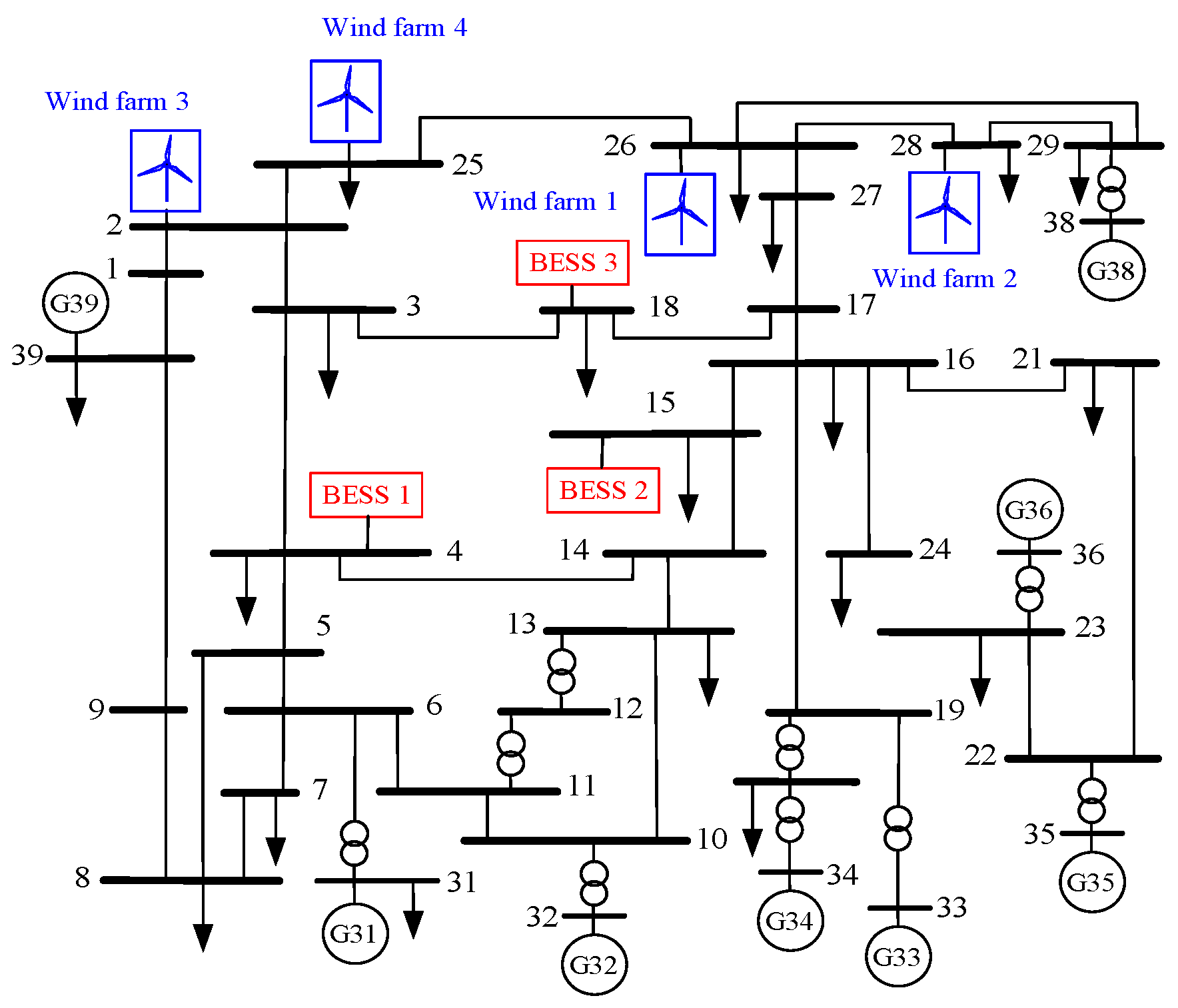
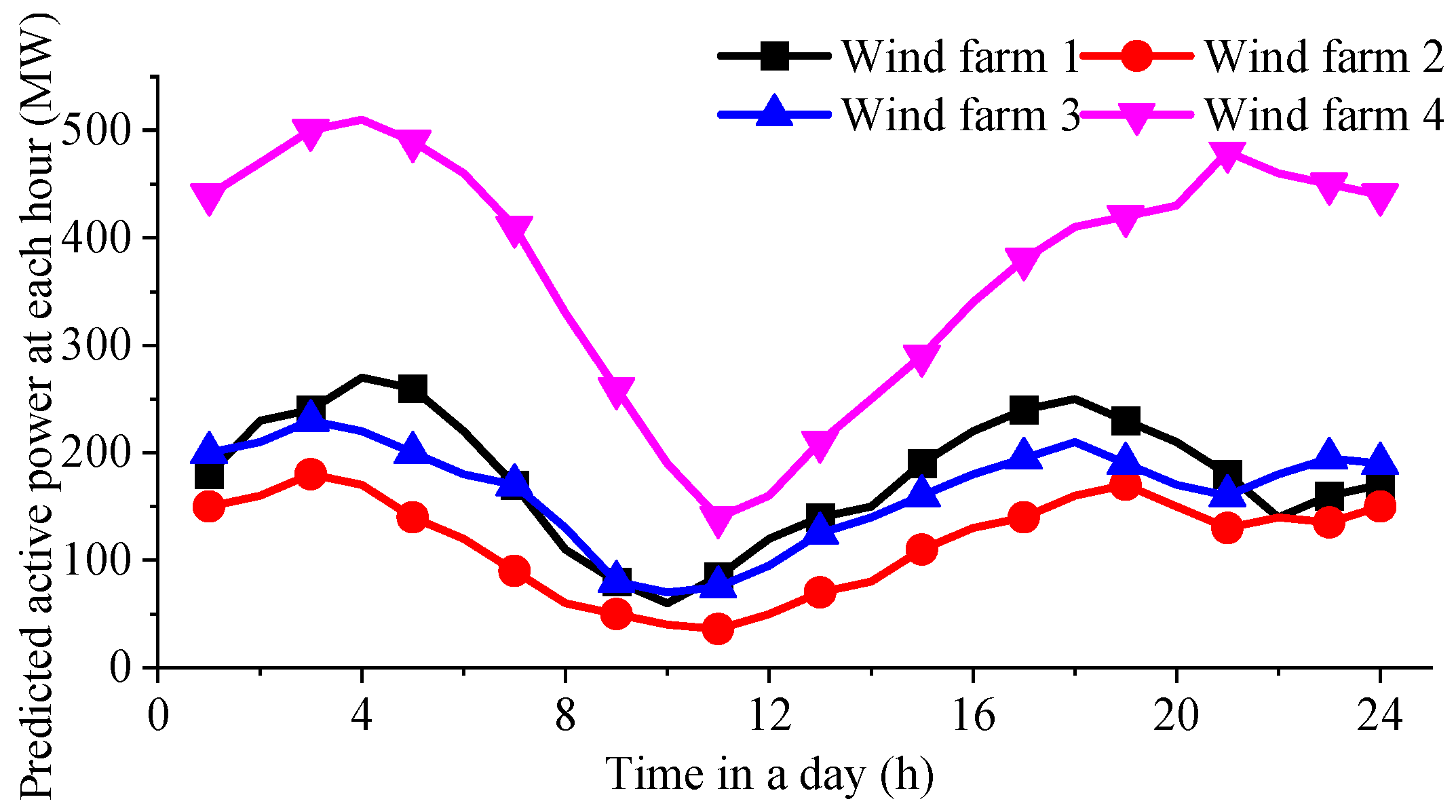
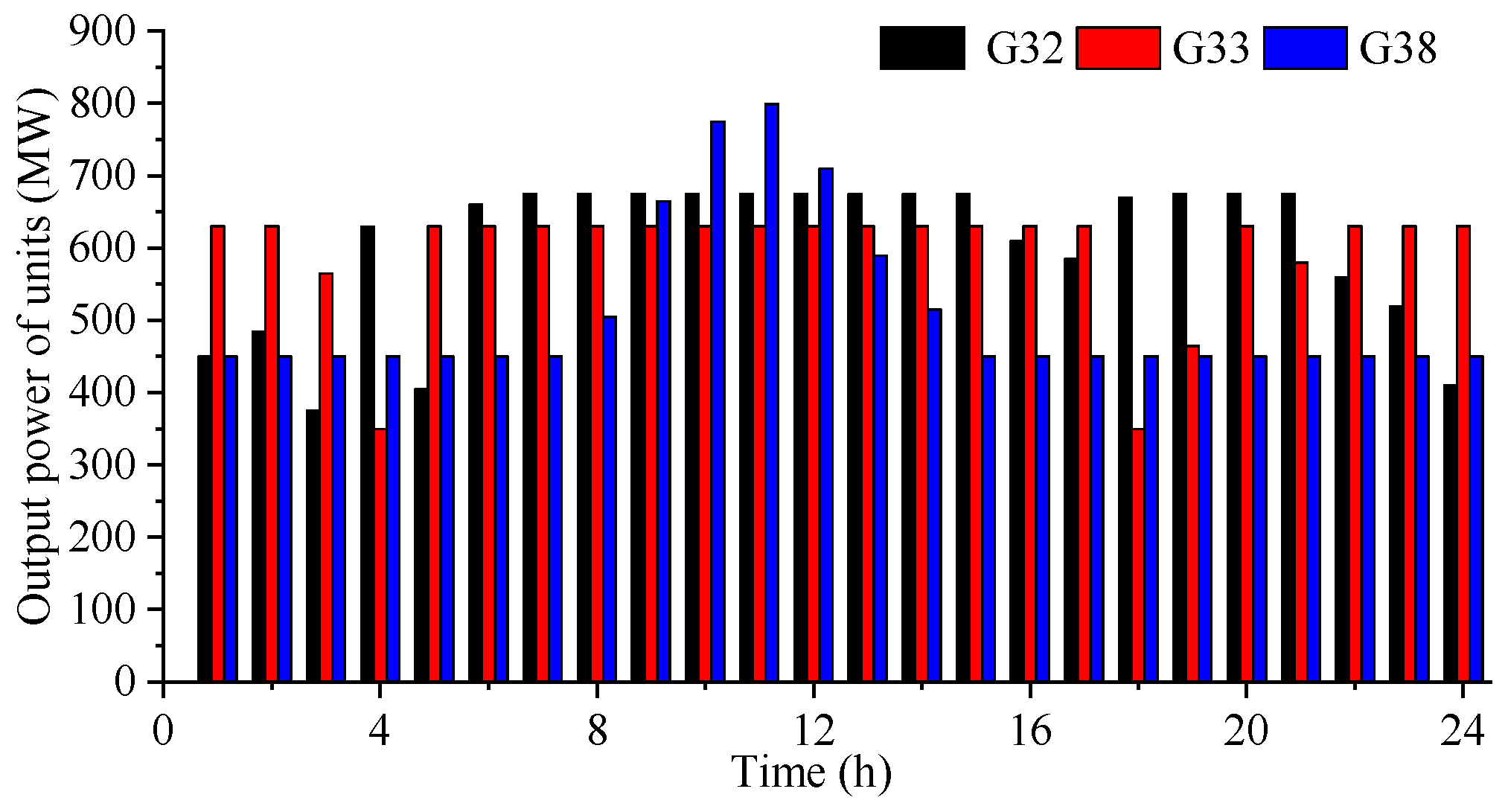

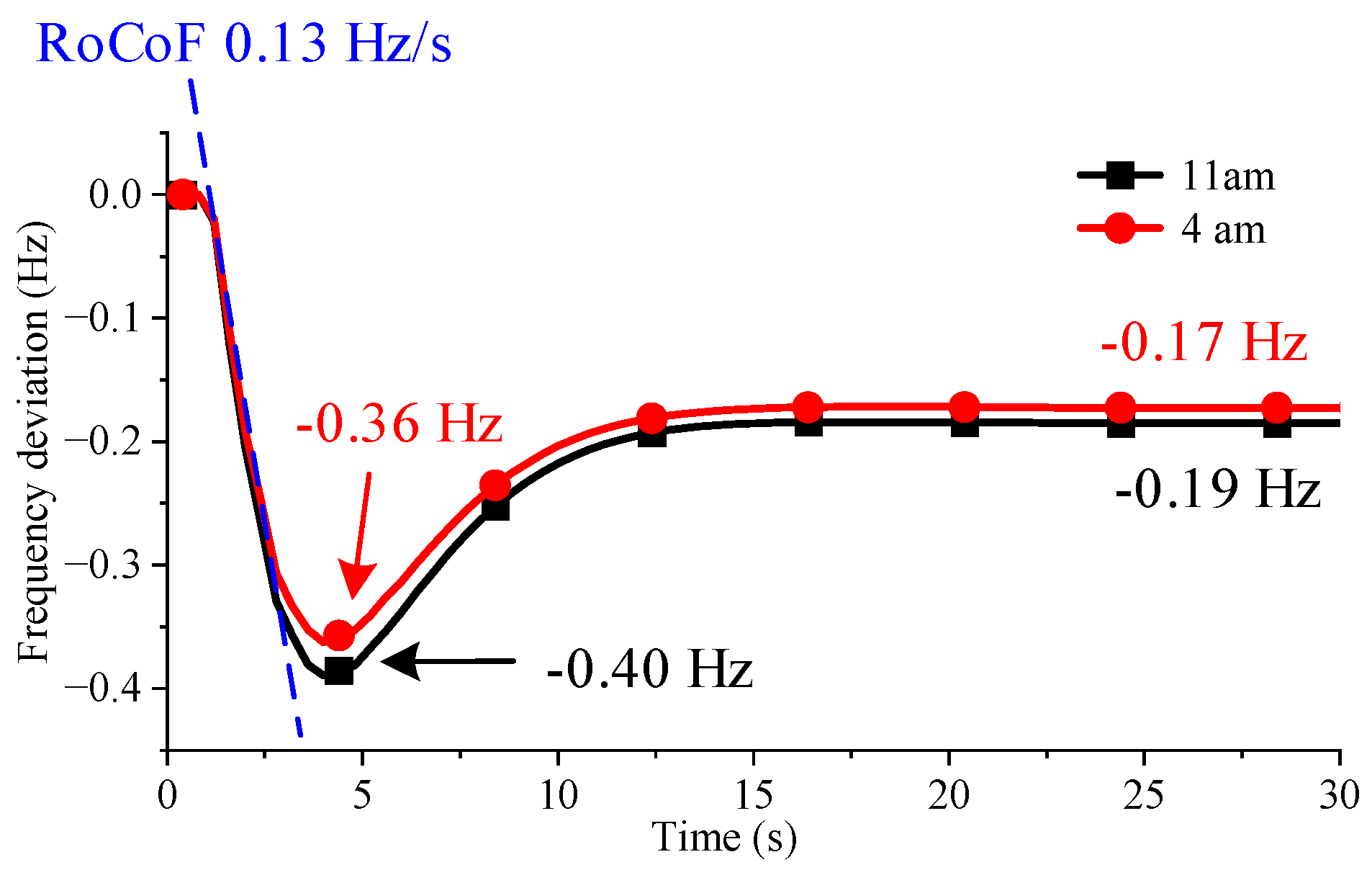

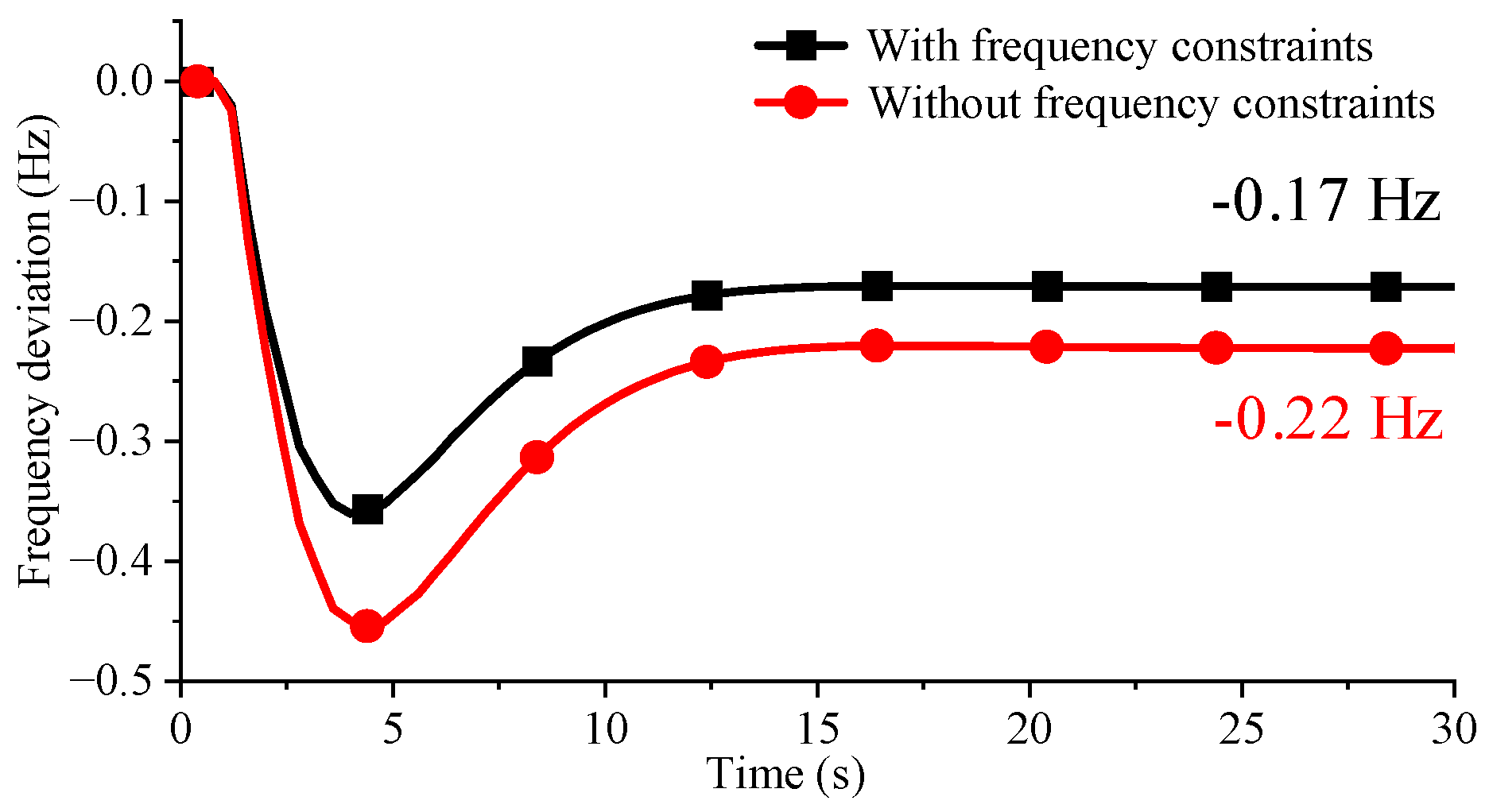
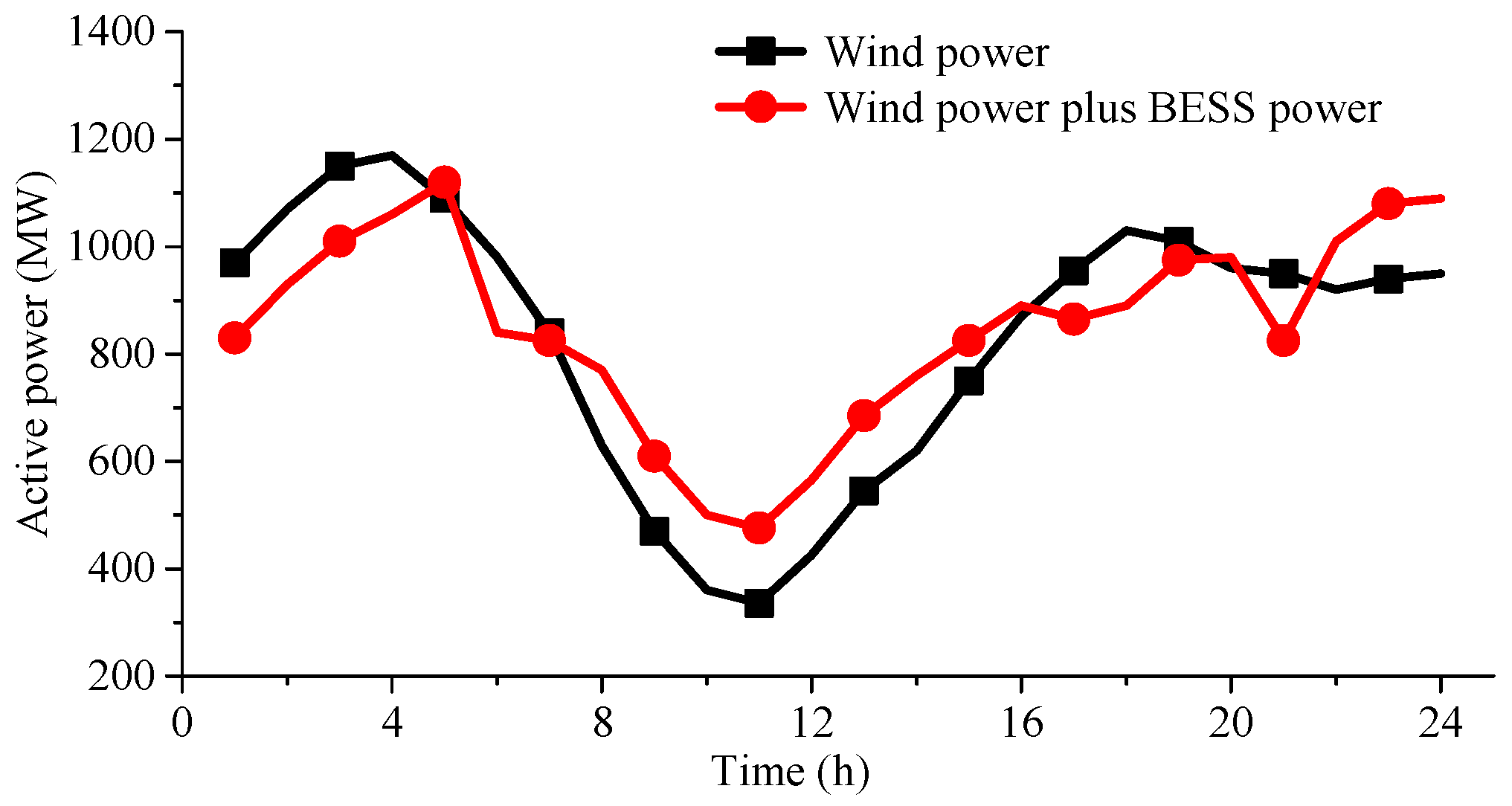
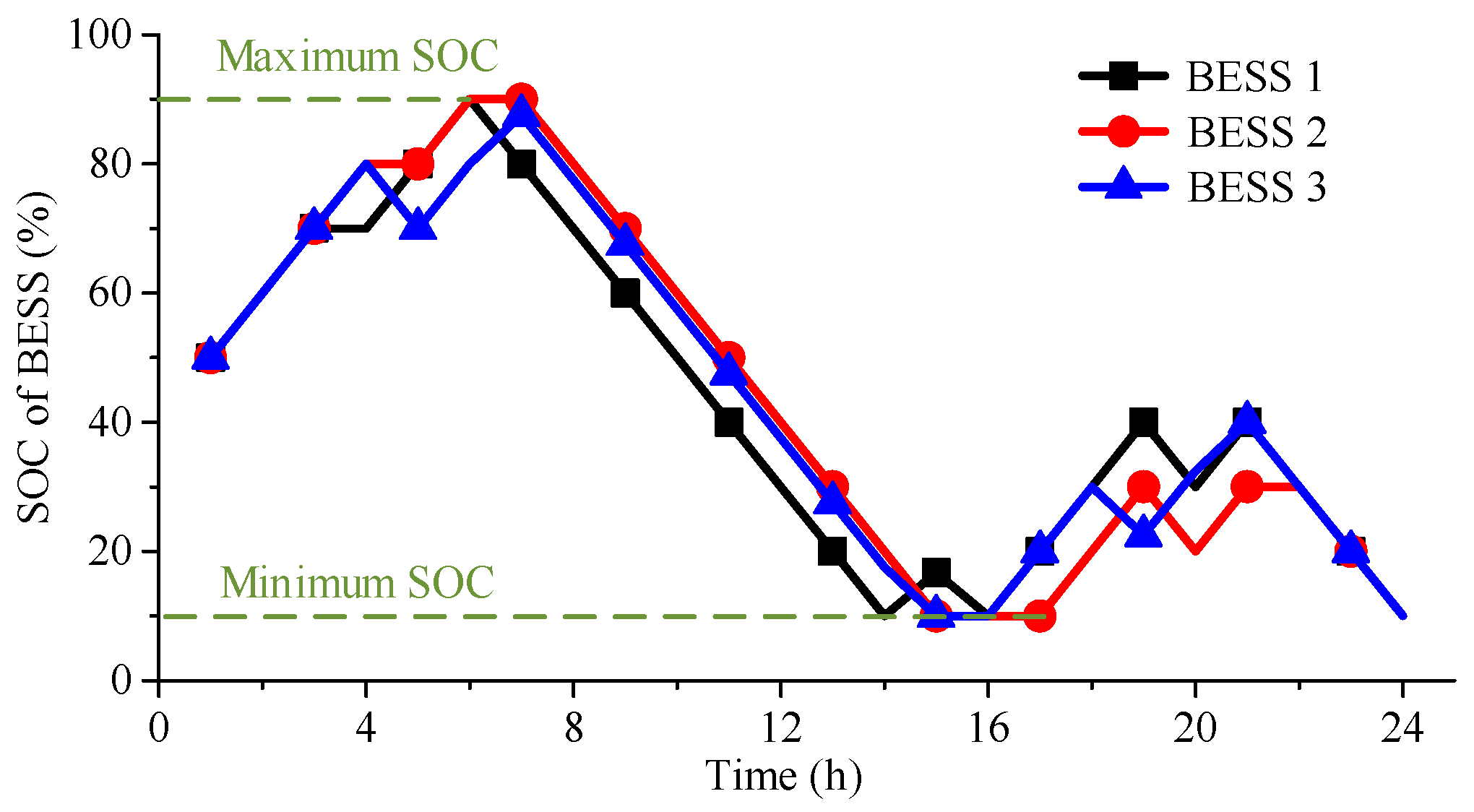
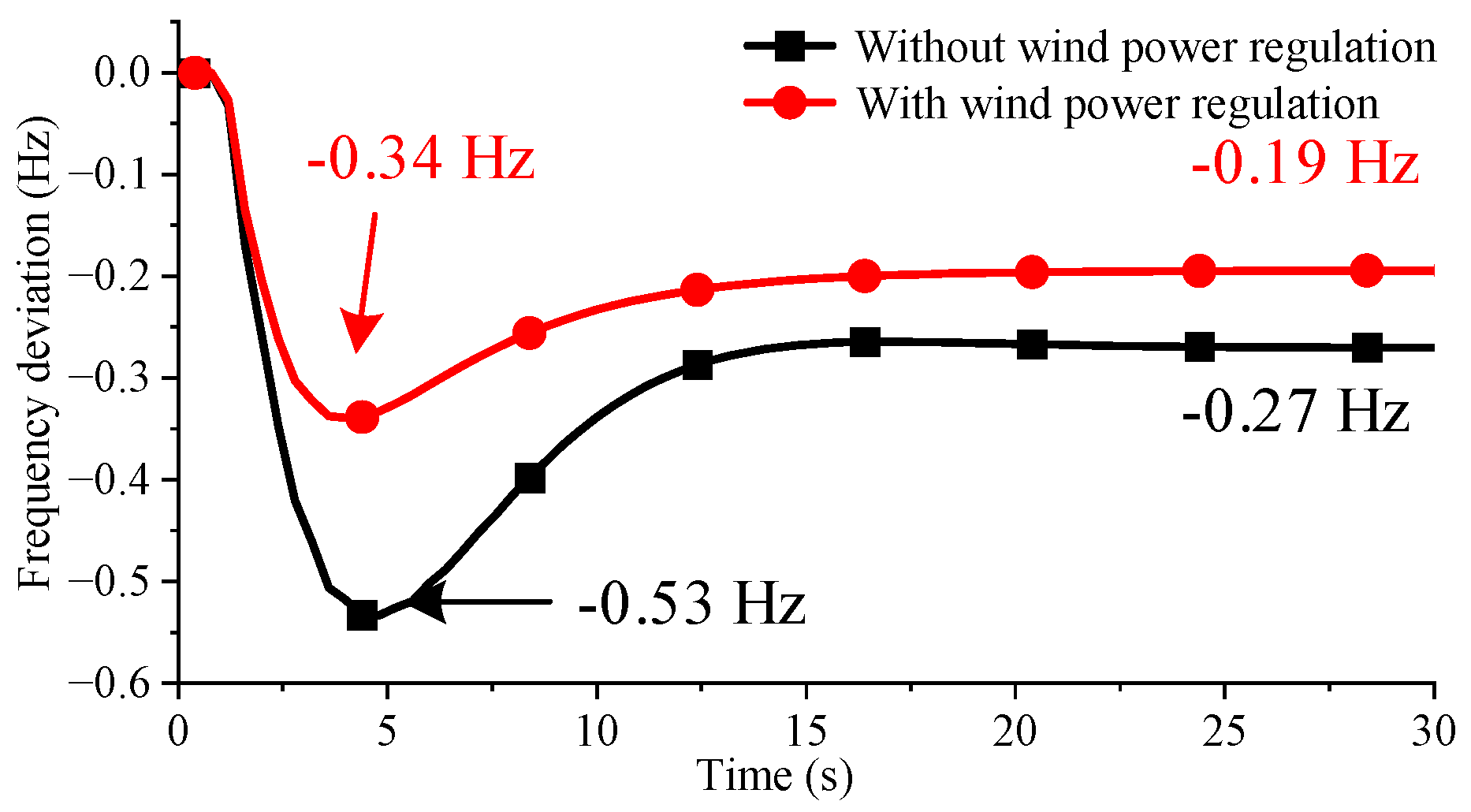
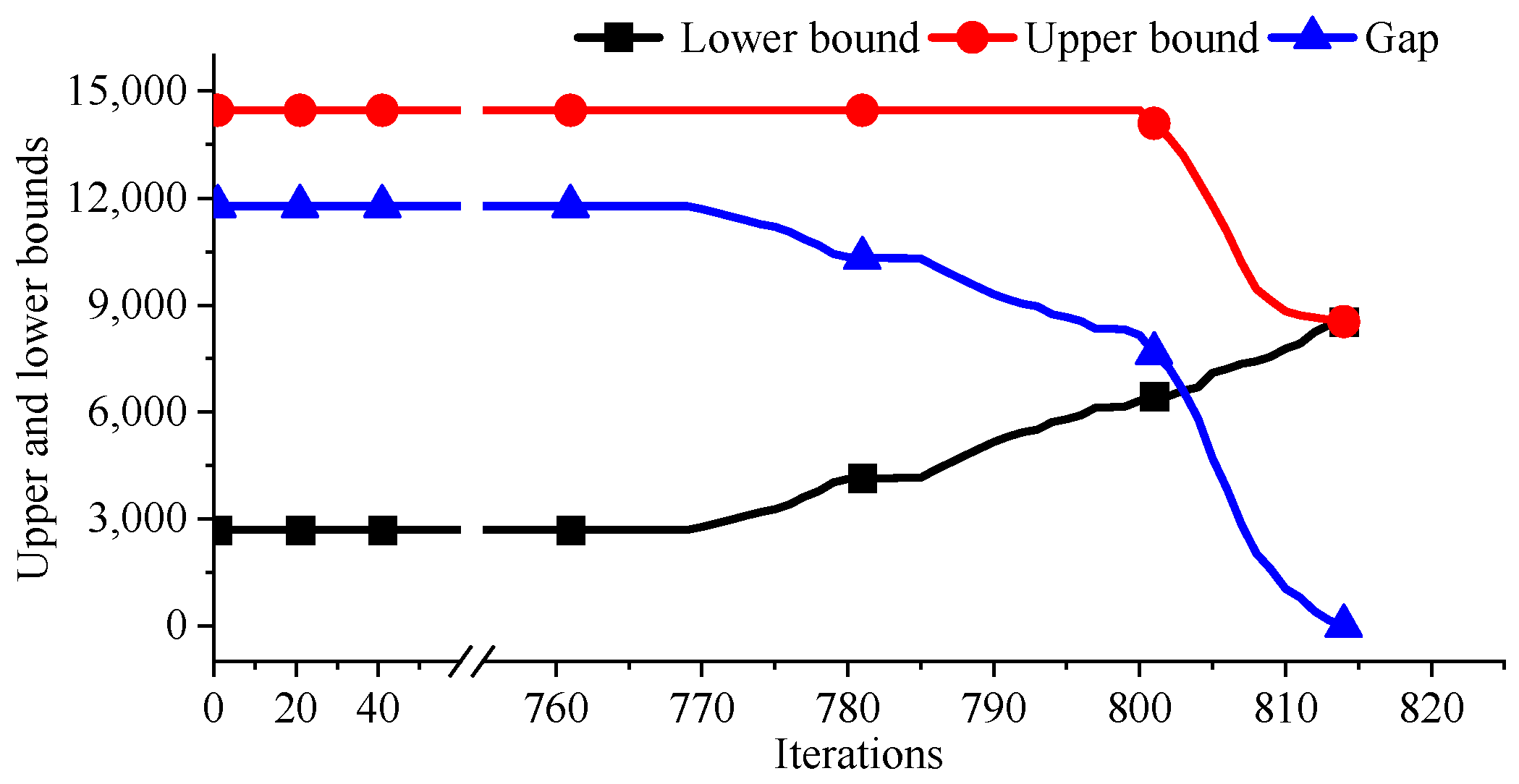

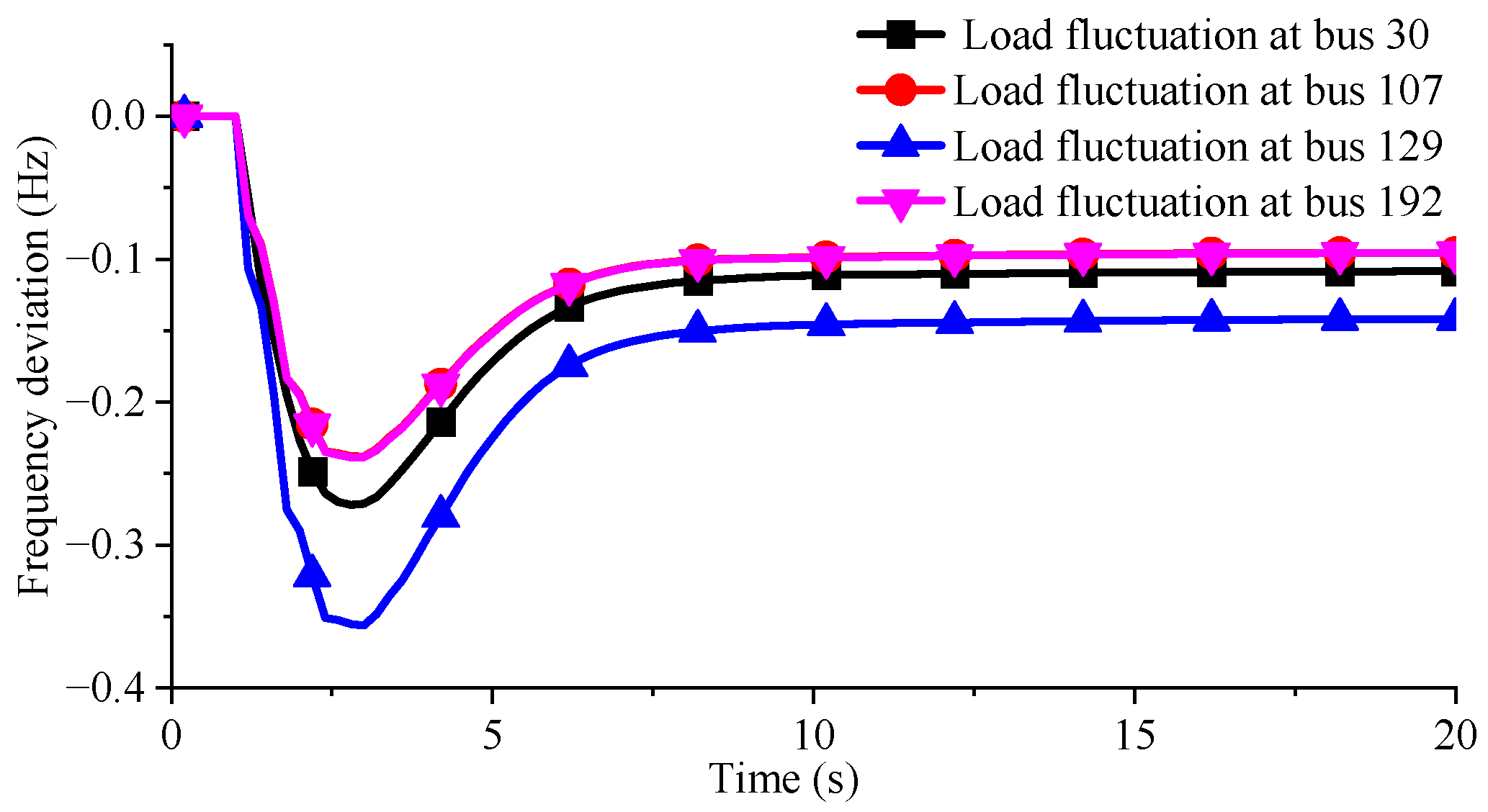
| Number of Units | Output Power/MW |
|---|---|
| G31 | 585 |
| G34 | 540 |
| G35 | 400 |
| G36 | 585 |
| G39 | 1800 |
| Methods | Margin of Frequency/% | Overshoot/% |
|---|---|---|
| The proposed method | 11 | 18 |
| Ref. [24] | 6 | 26 |
| Ref. [25] | 2 | 38 |
| Ref. [27] | 5 | 30 |
| Ref. [30] | 3 | 36 |
| Inertia/s | Margin of Frequency/% | Overshoot/% |
|---|---|---|
| 3 | 11 | 22 |
| 5 | 12 | 20 |
| 7 | 14 | 18 |
| 9 | 15 | 15 |
| Damping Ratio/pu | Margin of Frequency/% | Overshoot/% |
|---|---|---|
| 1 | 5 | 27 |
| 5 | 7 | 22 |
| 10 | 13 | 16 |
| 20 | 17 | 13 |
Disclaimer/Publisher’s Note: The statements, opinions and data contained in all publications are solely those of the individual author(s) and contributor(s) and not of MDPI and/or the editor(s). MDPI and/or the editor(s) disclaim responsibility for any injury to people or property resulting from any ideas, methods, instructions or products referred to in the content. |
© 2025 by the authors. Licensee MDPI, Basel, Switzerland. This article is an open access article distributed under the terms and conditions of the Creative Commons Attribution (CC BY) license (https://creativecommons.org/licenses/by/4.0/).
Share and Cite
Liu, H.; Xie, H.; Zhang, J.; Wang, G.; Huang, Y. Coordinated Operation Strategy for Large Wind Power Base Considering Wind Power Uncertainty and Frequency Stability Constraint. Energies 2025, 18, 4625. https://doi.org/10.3390/en18174625
Liu H, Xie H, Zhang J, Wang G, Huang Y. Coordinated Operation Strategy for Large Wind Power Base Considering Wind Power Uncertainty and Frequency Stability Constraint. Energies. 2025; 18(17):4625. https://doi.org/10.3390/en18174625
Chicago/Turabian StyleLiu, Hongtao, Huifan Xie, Jinning Zhang, Guoteng Wang, and Ying Huang. 2025. "Coordinated Operation Strategy for Large Wind Power Base Considering Wind Power Uncertainty and Frequency Stability Constraint" Energies 18, no. 17: 4625. https://doi.org/10.3390/en18174625
APA StyleLiu, H., Xie, H., Zhang, J., Wang, G., & Huang, Y. (2025). Coordinated Operation Strategy for Large Wind Power Base Considering Wind Power Uncertainty and Frequency Stability Constraint. Energies, 18(17), 4625. https://doi.org/10.3390/en18174625






